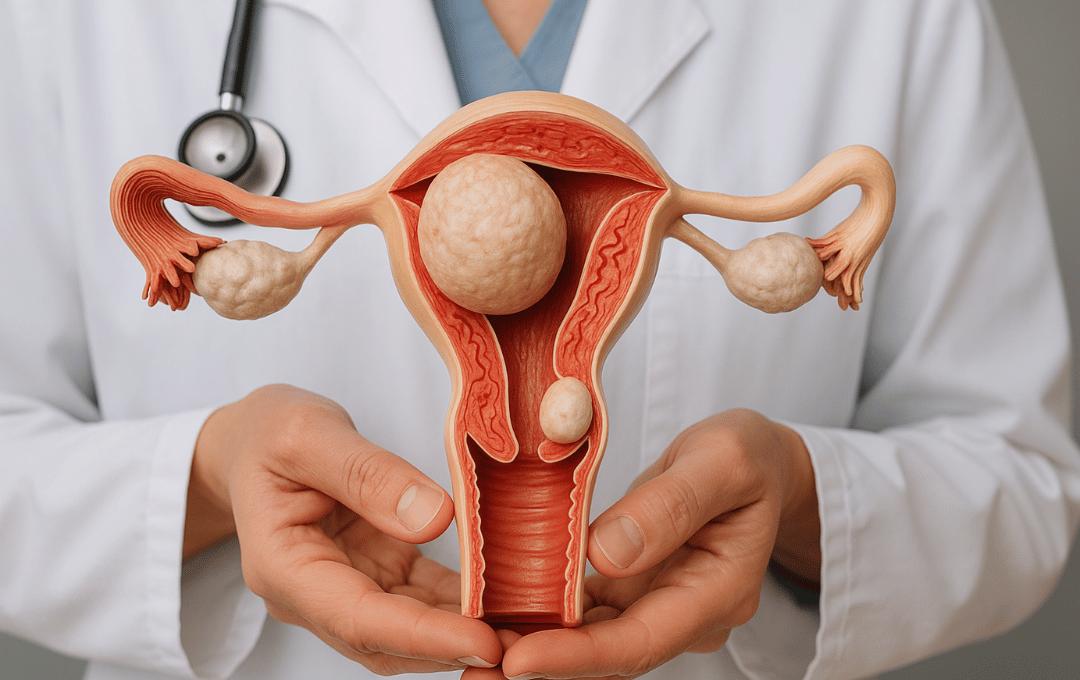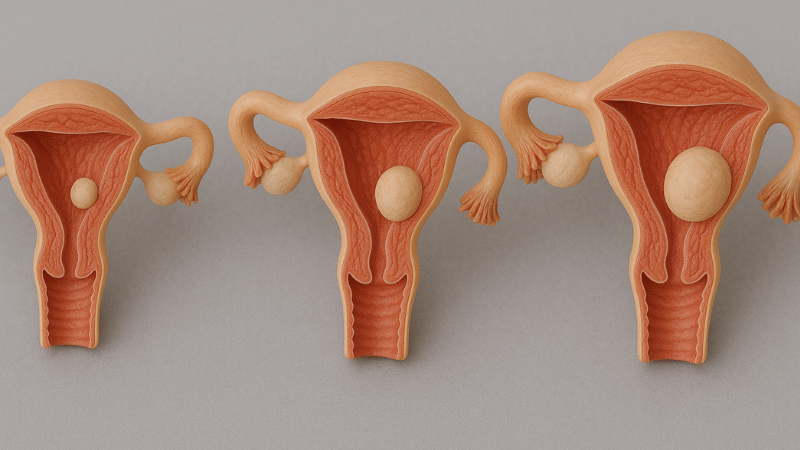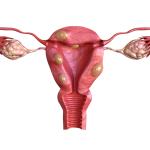
The size of a fibroid is often the first thing people worry about, but doctors will tell you size is rarely the only factor determining risk. It’s understandable, though, to still wonder which, if any, size of fibroid is dangerous.
Ultimately, the answer is complex.
come in various sizes, and large fibroids can typically lead to more severe symptoms. However, the type and severity of symptoms depend mainly on where the fibroid is growing. Here is what you need to know about which sizes of uterine fibroids may be considered dangerous and when you should consult a fibroid specialist about treatment.
How Are Fibroid Sizes Measured?
Before discussing which size of fibroid is dangerous, it’s important to understand what classifies as a small, medium, or large fibroid.
Fibroids are measured in millimeters (mm) or centimeters (cm) and are often compared to familiar objects for easier visualization.
Generally, the size of fibroids falls under:
| Category | Sizing | Notes |
| Small Fibroids | <2 cm |
|
| Medium Fibroids | 2–5 cm |
|
| Large Fibroids | 5–10+ cm |
|
To determine the exact size, number, and location of fibroids, specialists use imaging tests, such as ultrasound or MRI.
What are the Fibroid Sizes that can be Dangerous?
There is no single “dangerous” size of fibroid, as risk depends on factors which include not only the size, but also the location and type. Typically, when the size of the fibroid exceeds 50 mm (approximately 5cm), equivalent to the size of a golf ball, it is more likely to distort the uterus or other nearby organs, making the condition more severe. At this size, the fibroid is more likely to increase symptoms and long-term risks.
Even a smaller fibroid can cause issues if it is in a sensitive area. For example, a small intramural fibroid near the muscular wall of the uterus can trigger heavy bleeding. In contrast, a large subserosal fibroid on the outer wall of the uterus won’t necessarily cause any symptoms; however, this does not change the concern for serious health issues it can cause.
Which Size of Intramural Fibroid Is Dangerous?
Intramural fibroids develop inside the muscular wall of the uterus. Even at medium sizes (3–5 cm), they can affect the uterus’s shape, causing heavy bleeding, painful periods, or fertility challenges.
If intramural fibroids grow beyond 5 cm, they may distort the uterine cavity and require medical attention.
Which Size of Subserosal Fibroid Is Dangerous?
Subserosal fibroids develop on the outer wall of the uterus, which can cause them to press against nearby organs.
Larger ones, typically 7–10 cm or more, may cause urinary frequency, constipation, or a feeling of fullness in the abdomen. Though they rarely cause heavy bleeding, their size and pressure on nearby organs can impact quality of life.
If you’re experiencing pelvic pressure or discomfort, schedule a fibroid evaluation to learn your options for relief.
Which Size of Fibroid is Dangerous During Pregnancy?
Fibroids don’t always interfere with pregnancy, but larger fibroids (over 5 cm) can increase certain risks.
Possible complications include:
- Miscarriage
- Preterm labor
- Cesarean delivery
Fibroid location is equally important. A large fibroid near the uterine lining can interfere with embryo implantation or restrict fetal growth.
If you have fibroids and are planning to become pregnant, seeking early monitoring and non-surgical treatment such as uterine fibroid embolization (UFE) before conception can help lower these risks.
Which Size of Fibroid Needs Surgery or Treatment?
Generally, fibroids less than 3 cm that are not causing symptoms can be monitored using regular imaging. For fibroids larger than 5 cm, however, they are more likely to require treatment.
Regardless of size, fibroids may require treatment if they cause:
- Heavy or irregular menstrual bleeding
- Chronic pelvic pain or pressure
- Difficulty becoming pregnant
- Rapid growth over a short period
Whether a fibroid requires treatment depends not only on its size but also on its location and the severity of the fibroid symptoms.
How to Reduce the Size of Fibroids
Effectively reducing fibroid size requires medical treatment, like a hysterectomy or non-surgical options like hormonal therapy or uterine fibroid embolization (UFE). Making lifestyle adjustments, such as eating a healthy diet and developing an exercise routine, may help manage fibroid-related symptoms, but they don’t shrink fibroids.
Hormonal therapy can temporarily control bleeding and growth, but doesn’t offer a long-term solution to managing fibroid symptoms. UFE, however, is a minimally invasive, in-office procedure that cuts off the fibroid’s blood supply, allowing it to shrink naturally over time and targeting the root cause of fibroid symptoms. This treatment is effective for fibroids of all sizes and types, helping patients manage symptoms and improve quality of life.
Expert Care and Treatment for Fibroids of All Sizes
The size of fibroid tumors doesn’t determine whether they’re dangerous, as location, symptoms, and growth rate matter just as much. However, specific warning signs can signal it’s time to consult a fibroid specialist.
These warning signs include:
- Rapidly growing fibroids
- Fibroids larger than 5 cm
- Fertility challenges
- Persistent pain or heavy bleeding
Our fibroid specialists at USA Fibroid Centers are experts who diagnose fibroids based on their size, location, and symptoms, to create a personalized treatment plan for you, offering non-surgical uterine fibroid embolization (UFE).
Schedule an appointment to consult with our fibroid specialists today to begin your journey toward lasting relief.
FAQs About The Dangers of Fibroid Size
Which size of fibroid is considered normal?
The “normal” size range for fibroids is 5 cm to 10 cm. Though size can impact symptom severity, the location and quantity of fibroids are also significant factors.
Can fibroids of the same size behave differently in different people?
Fibroids of the same size can behave differently depending on the individual, especially based on the fibroid’s location. For example, a large subserosal fibroid on the outside of the uterus behaves differently from a large intramural fibroid within the uterine muscular wall.
Does the size of fibroids affect recovery time after treatment?
The size of the fibroids can affect recovery time by influencing the type of treatment required. Larger or multiple fibroids may lead to longer recovery depending on the procedure performed.




